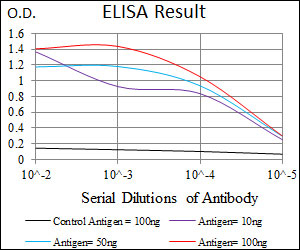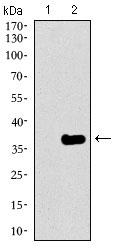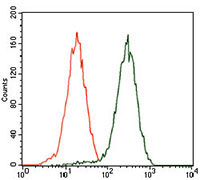GATA6 Antibody
Purified Mouse Monoclonal Antibody
- 产品详情
- 实验流程
- 背景知识
Application
| WB, FC, ICC, E |
|---|---|
| Primary Accession | Q92908 |
| Reactivity | Human |
| Host | Mouse |
| Clonality | Monoclonal |
| Clone Names | 2F10G3 |
| Isotype | IgG1 |
| Calculated MW | 60033 Da |
| Description | This gene is a member of a small family of zinc finger transcription factors that play an important role in the regulation of cellular differentiation and organogenesis during vertebrate development. This gene is expressed during early embryogenesis and localizes to endo- and mesodermally derived cells during later embryogenesis and thereby plays an important role in gut, lung, and heart development. Mutations in this gene are associated with several congenital defects. |
| Immunogen | Purified recombinant fragment of human GATA6 (AA: 491-557) expressed in E. Coli. |
| Formulation | Purified antibody in PBS with 0.05% sodium azide |
| Gene ID | 2627 |
|---|---|
| Other Names | Transcription factor GATA-6, GATA-binding factor 6, GATA6 |
| Dilution | WB~~1/500 - 1/2000 FC~~1/200 - 1/400 ICC~~N/A E~~1/10000 |
| Storage | Maintain refrigerated at 2-8°C for up to 6 months. For long term storage store at -20°C in small aliquots to prevent freeze-thaw cycles. |
| Precautions | GATA6 Antibody is for research use only and not for use in diagnostic or therapeutic procedures. |
| Name | GATA6 |
|---|---|
| Function | Transcriptional activator (PubMed:19666519, PubMed:22750565, PubMed:22824924, PubMed:27756709). Regulates SEMA3C and PLXNA2 (PubMed:19666519). Involved in gene regulation specifically in the gastric epithelium (PubMed:9315713). May regulate genes that protect epithelial cells from bacterial infection (PubMed:16968778). Involved in bone morphogenetic protein (BMP)-mediated cardiac-specific gene expression (By similarity). Binds to BMP response element (BMPRE) DNA sequences within cardiac activating regions (By similarity). In human skin, controls several physiological processes contributing to homeostasis of the upper pilosebaceous unit. Triggers ductal and sebaceous differentiation as well as limits cell proliferation and lipid production to prevent hyperseborrhoea. Mediates the effects of retinoic acid on sebocyte proliferation, differentiation and lipid production. Also contributes to immune regulation of sebocytes and antimicrobial responses by modulating the expression of anti- inflammatory genes such as IL10 and pro-inflammatory genes such as IL6, TLR2, TLR4, and IFNG. Activates TGFB1 signaling which controls the interfollicular epidermis fate (PubMed:33082341). |
| Cellular Location | Nucleus |
| Tissue Location | Expressed in heart, gut and gut-derived tissues. Expressed in skin upper pilosebaceous unit. Expression is decreased or lost in acne lesions (PubMed:33082341). |
For Research Use Only. Not For Use In Diagnostic Procedures.
Provided below are standard protocols that you may find useful for product applications.
BACKGROUND
The protein encoded by this gene is a member of the fibroblast growth factor (FGF) family. FGF family members possess broad mitogenic and cell survival activities and are involved in a variety of biological processes including embryonic development, cell growth, morphogenesis, tissue repair, tumor growth and invasion. This gene was identified by its oncogenic transforming activity. This gene and FGF3, another oncogenic growth factor, are located closely on chromosome 11. Co-amplification of both genes was found in various kinds of human tumors. Studies on the mouse homolog suggested a function in bone morphogenesis and limb development through the sonic hedgehog (SHH) signaling pathway.
REFERENCES
1. BMC Cancer. 2012 Jun 6;12:218. 2. Neonatology. 2011;99(3):231-40.
终于等到您。ABCEPTA(百远生物)抗体产品。
点击下方“我要评价 ”按钮提交您的反馈信息,您的反馈和评价是我们最宝贵的财富之一,
我们将在1-3个工作日内处理您的反馈信息。
如有疑问,联系:0512-88856768 tech-china@abcepta.com.























 癌症的基本特征包括细胞增殖、血管生成、迁移、凋亡逃避机制和细胞永生等。找到癌症发生过程中这些通路的关键标记物和对应的抗体用于检测至关重要。
癌症的基本特征包括细胞增殖、血管生成、迁移、凋亡逃避机制和细胞永生等。找到癌症发生过程中这些通路的关键标记物和对应的抗体用于检测至关重要。 为您推荐一个泛素化位点预测神器——泛素化分析工具,可以为您的蛋白的泛素化位点作出预测和评分。
为您推荐一个泛素化位点预测神器——泛素化分析工具,可以为您的蛋白的泛素化位点作出预测和评分。 细胞自噬受体图形绘图工具为你的蛋白的细胞受体结合位点作出预测和评分,识别结合到自噬通路中的蛋白是非常重要的,便于让我们理解自噬在正常生理、病理过程中的作用,如发育、细胞分化、神经退化性疾病、压力条件下、感染和癌症。
细胞自噬受体图形绘图工具为你的蛋白的细胞受体结合位点作出预测和评分,识别结合到自噬通路中的蛋白是非常重要的,便于让我们理解自噬在正常生理、病理过程中的作用,如发育、细胞分化、神经退化性疾病、压力条件下、感染和癌症。









